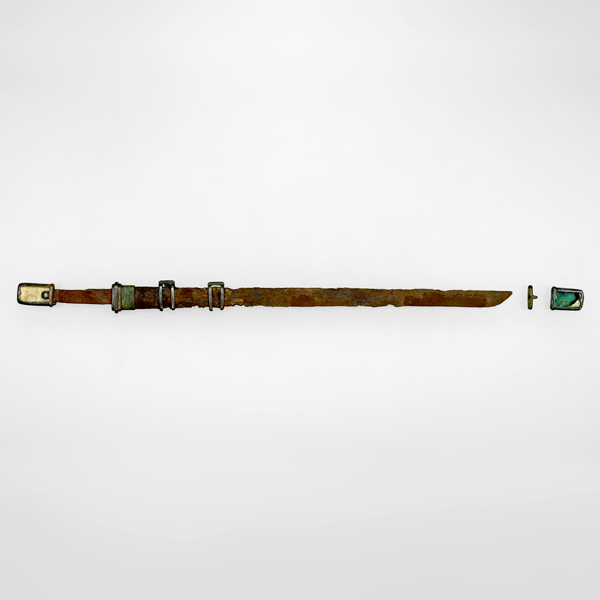Late Burial Mounds and Influence from the Asian Continent
-

Sword with a Square Pommel
Found in Fujioka City, Gunma, Kofun (Asuka) period, 7th centuryJapanese Archaeology and Special Exhibition (Heiseikan) Japanese Archaeology Gallery
June 4, 2024 (Tue) - November 4, 2024 (Mon)At the end of the 6th century, significant changes accompanied the shift from the Kofun to the Asuka (593–710) period. Rulers constructed round or rectangular burial mounds, which replaced the older keyhole-shaped variety. In the mid-7th century, octagonal burial mounds were created for the Kings of Yamato, the most powerful rulers in Japan. Moreover, small burial mounds for individuals, which consisted of a stone chamber with an entrance, were built in the Kinai region. These developments reflect significant changes in burial practices.
These “late burial mounds” featured the latest technology imported from the Asian continent. Earth was tightly packed to strengthen construction, cut stones were stacked to create walls, and lacquered coffins were used. Some of these mounds, foremost of which are Takamatsu and Kitora, had burial chambers with painted murals that reflected imported beliefs.
Buddhism, which was introduced to Japan in the mid-6th century, spread among powerful clans while temples such as Asukadera and Horyuji were constructed in Nara. Meanwhile, China was unified under the Sui in 581 and the Tang in 618. Japanese envoys dispatched to China brought the latest culture to Japan. In Korea, the kingdom of Baekje fell in 660 to the combined armies of Tang and Silla despite Japanese aid. The creation of a unified state continued in Japan during this time of international tension.
| Designation | Name | Creation/ Excavation/ Provenance |
Period | Acquisition/ Ownership/ Accession Number |
CMT | ||
| Highlight | Mirror with Sea Beasts and Grapes | Found at Matsuyama Tumulus, Nara | Kofun period, 7th century | J-4866 | |||
| Highlight | Mirror with Silver Inlay | Found at Matsuyama Tumulus, Nara | Kofun (or Asuka) period, 7th century | J-2191 | |||
| Highlight | Sword with a Square Pommel | Found in Fujioka City, Gunma | Kofun (Asuka) period, 7th century | J-13924 | |||
| Highlight | Small Ceramic Coffin | Found in Ōta City, Gunma | Kofun (Asuka)–Nara period, 7th–8th century | Gift of Mr. Takano Yasaburō, J-6024 | |||
| Highlight | Ceramic Coffin | Found in Mimasaka City, Okayama | Kofun (Asuka) period, 7th century | J-2673 |
